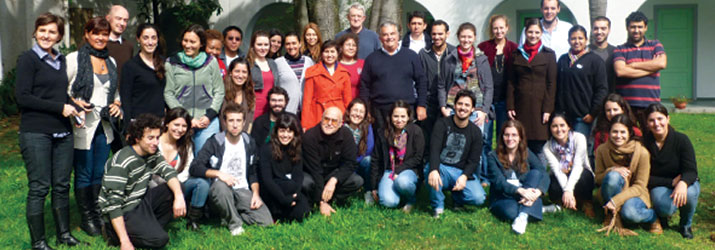
Buenos Aires, the vibrant capital of Argentina, was host for four days to the 2012 5th Special Conference of the International Society for Neurochemistry (ISN). In 2004 the International Society for Neurochemistry began a series of Special Conferences to serve as a forum for reporting outstanding research and development and novel techniques in the field. The first Special Conference took place in Avignon, France, and focused on “Changes in Neuronal Gene Expression and CNS Drug Responses”. The second, on “Neural Glycomics and Lipidomics” was held in Antigua, West Indies, in 2006. The 3rd Special Conference, entitled “Neurodegene-ration and Regeneration” was held in Beijing in 2008, and the 4th was held in Erice, Sicily, in May 2010 on “Membrane Domains in CNS Physiology and Pathology”.
For this year’s conference over 140 neuroscientists from around the world gathered at the convention centre of the Catholic University of Argentina, located in the area of Buenos Aires known as Puerto Madero. Formerly the city’s main port and then abandoned for decades, Puerto Madero waterfront is now a complex of boulevards with modern buildings and red-brick warehouses totally refurbished into offices, residences, hotels, banks, and trendy restaurants with the most varied international cuisine and pubs.
The topic of the 2012 5th ISN Special Conference in Buenos Aires was ‘Synapses and dendritic spines in health and disease’, a rapidly moving subject at the forefront of the Neurosciences. The dendrites of neurons receive and incorporate input from thousands of partner cells. The majority of the incoming informational traffic occurs at highly specialised structures termed synapses, distributed all over the dendritic branching of the input neuron. Improper function and/or abnormal regulation of synaptic transmission are implicated in countless neurological and psychiatric disorders. Disturbances of neurotransmission has been associated with the pathophysiology of diseases ranging from schizophrenia, depression and autism to epilepsy and addiction, and increasing evidence suggests that synapses are among the earliest targets in the pathogenesis of Alzheimer’s and other CNS diseases. We now refer to this wide variety of pathologies as “synaptopathies”.
Understanding the complexity of synapse structure and function, and in particular, how these two properties are linked to regulate circuit function and behaviour, is a major driving force in the field of dendritic spine biology. These structure-function studies are leading to amazing advances in our understanding of CNS diseases.
A group of eminent neuroscientists like Alessandro Prinetti from the University of Milano, Italy; Tomoaki Shirao, from Gunma University, Maebashi, Japan; Peter Penzes, from Northwestern University in Chicago, USA, and Gavin Rumbaugh, from The Scripps Florida Research Institute, in Jupiter, USA, actively collaborated with the local organising committee (Laura Morelli, Ana Belén Elghoyen, Jorge Medina and Javier Baier, all from Buenos Aires) and myself to put together an exciting scientific programme.
During the Special Conference in Buenos Aires several presentations dealt with the application of the latest advanced methodologies to tackle the study of synapses and dendritic spines in animal or human subjects. Light microscopy has undergone a revolution in the field. The centuries-old light microscope has now broken the diffraction-limit, allowing unprecedented resolution in studying cells. In the case of the nervous tissue, this has resulted in the application of new high-resolution, high-speed imaging techniques like STED, SIM or STORM modalities of superresolution microscopy (“nanoscopy”) to the study of the synapse and the tiny dendritic spines. These new methods are at the vanguard of research in the field, and are being developed and can already be applied to cultured neurons and even live animals to examine the temporal domain and spatial features of the molecular events at individual, living synapses. However powerful these exquisitely refined analytical techniques may be, they nevertheless fall short of unraveling the integrative aspects of synaptic ensembles and neuronal networks, which were covered in other presentations at the meeting.
Neuroscientists and students alike engaged in lively discussions on the latest advances in homeostatic plasticity in neurons, neuronal polarity, pre-and postsynaptic long-term potentiation and depression at central nervous system synapses, the organisation of neurotransmitter receptors in normal and diseased synapses, and detailed dissection of molecular components in dendritic spines themselves. A group of 15 young participants from Argentina, Brazil, Chile, Colombia, India, Mexico, Uruguay, and the U.S.A. were “primed” during the Advanced School on Neurochemistry held during the previous fortnight in Buenos Aires and Montevideo, Uruguay, with the more sophisticated subjects dealt with at the Special Conference. In addition to these 15 young participants, around 25 doctoral students/postdocs from around the world received scholarships to participate in the Conference, making the input from the audience a vibrant and dynamic learning process for all attendees alike.
The opening plenary lecture, by Nobel Awardee Erwin Neher (“Biophysics of neurotransmitter release and short-term plasticity”), and the closing lecture, by Morgan Sheng (“Life, Death and Disease of Synapses”), spanned the field from the basic biophysical foundations of neurotransmission to the more integrative facets of current research on the synapse and higher circuits, impinging on behavioural consequences of synaptic alterations.
In summary, by focusing on the synapse and synaptopathies, the 2012 ISN Special Conference brought together leading researchers in the field of synapse biology in an attempt to forge a path toward a better understanding of how synapses and circuits contribute to important neurological and psychiatric disease processes.

